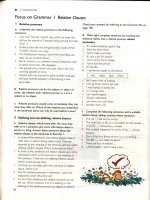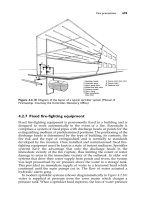E 574 13
Bạn đang xem bản rút gọn của tài liệu. Xem và tải ngay bản đầy đủ của tài liệu tại đây (90.27 KB, 4 trang )
Designation: E574 − 13
Standard Specification for
Duplex, Base Metal Thermocouple Wire With Glass Fiber or
Silica Fiber Insulation1
This standard is issued under the fixed designation E574; the number immediately following the designation indicates the year of
original adoption or, in the case of revision, the year of last revision. A number in parentheses indicates the year of last reapproval. A
superscript epsilon (´) indicates an editorial change since the last revision or reapproval.
3.2.1 amorphous silica fiber, n—continuous filament of heat
insulating material whose principal constituent is amorphous
silica.
3.2.2 duplex wire, n—matched pair of parallel, solid
thermoelements, individually insulated (double wrap or braid)
with insulating fibers and a fiber braid of the same material
overall.
3.2.3 E-glass, n—family of calcia-alumina-silicate glasses
that are used for general purposes and most electrical applications.
3.2.4 impregnate, v—to saturate the fiber insulation of wires
with a high-temperature electrical insulating compound to form
a moisture barrier around the wires and to inhibit fraying of the
fibers.
3.2.5 polycrystalline fiber, n—continuous polycrystalline
filament of heat insulating material whose composition is
alumina, boria, and silica in an approximate ratio of 3:1:2,
respectively.
3.2.6 S-glass, n—family of magnesia-alumina-silicate
glasses with a higher tensile strength and higher softening
temperature than E-glass.
1. Scope
1.1 This specification sets forth the requirements for duplex,
types E, J, K, N and T thermocouple wire, insulated with
E-glass, S-glass, amorphous silica fiber or polycrystalline fiber.
1.2 The values stated in SI units are to be regarded as
standard. The values given in parentheses are for information
only.
1.3 This standard does not purport to address all of the
safety problems, if any, associated with its use. It is the
responsibility of the user of this standard to establish appropriate safety and health practices and determine the applicability of regulatory limitations prior to use.
2. Referenced Documents
2.1 ASTM Standards:2
D1125 Test Methods for Electrical Conductivity and Resistivity of Water
E207 Test Method for Thermal EMF Test of Single Thermoelement Materials by Comparison with a Reference Thermoelement of Similar EMF-Temperature Properties
E220 Test Method for Calibration of Thermocouples By
Comparison Techniques
E230 Specification and Temperature-Electromotive Force
(EMF) Tables for Standardized Thermocouples
E344 Terminology Relating to Thermometry and Hydrometry
4. Significance and Use
4.1 This specification presents the requirements for impregnated and non-impregnated fiber insulated thermocouple wire
for normally accepted industrial use, but does not attempt to
define such usage.
3. Terminology
4.2 A supplement contains the requirements for insulated
thermocouple wire that will be exposed to high humidity. The
purchase order or inquiry shall specify if this supplement is
required.
3.1 Definitions—The definitions given in Terminology E344
shall apply to this standard.
3.2 Definitions of Terms Specific to This Standard:
5. Classification
1
This specification is under the jurisdiction of ASTM Committee E20 on
Temperature Measurement and is the direct responsibility of Subcommittee E20.04
on Thermocouples.
Current edition approved May 1, 2013. Published July 2013. Originally approved
in 1976. Last previous edition approved in 2006 as E574 – 06. DOI: 10.1520/
E0574-13.
2
For referenced ASTM standards, visit the ASTM website, www.astm.org, or
contact ASTM Customer Service at For Annual Book of ASTM
Standards volume information, refer to the standard’s Document Summary page on
the ASTM website.
5.1 Class A–Duplex—E-glass fiber insulated, impregnated
with a high-temperature electrical insulating compound and
color coded in accordance with Specification E230.
5.2 Class B–Duplex—E-glass fiber insulated (Note 1) not
impregnated and not color coded.
5.3 Class C–Duplex—Amorphous silica fiber insulated
(Note 2) not impregnated and not color coded.
Copyright © ASTM International, 100 Barr Harbor Drive, PO Box C700, West Conshohocken, PA 19428-2959. United States
1
E574 − 13
7.1.3.1 Standard Method—When required by the purchase
order, calibration of the insulated thermocouple wire shall be
performed by one of the procedures described in Test Methods
E207 or E220.
7.1.3.2 Thermoelement Initial Calibration Tolerances
—Standard and special tolerances on initial values of emf
versus temperature are given in Table 1 of Specification E230.
The purchase order shall specify whether standard or special
tolerances are required.
5.4 Class D–Duplex—Polycrystalline fiber insulated (Notes
2 and 3) not impregnated and not color coded.
5.5 Class E–Duplex—S-glass fiber insulated, impregnated
with a high-temperature electrical insulating compound and
color coded in accordance with Specification E230.
5.6 Class F–Duplex—S-glass fiber insulated (Note 1) not
impregnated and not color coded.
NOTE 1—May be heat treated to retard fraying when specified in
ordering information (6.1.8).
NOTE 2—Fibers may be pre-treated with an organic compound to
facilitate braiding.
NOTE 3—May be heat cleaned after braiding to remove organic
compound when specified in ordering information (6.1.8).
7.2 Insulation Materials:
7.2.1 Individual thermoelements shall be covered with a
braid, or double wrap (one wrap in each direction) of glass
fibers (Classes A and E), a braid of glass fibers (Classes B and
F), or braid of fibers (Classes C and D).
7.2.2 The outer covering shall consist of a braid of the same
material applied over the bare thermoelements.
7.2.3 For Classes A and E duplex thermoelements, the
insulation on the individual thermoelements and the outer braid
shall be impregnated with a moisture and heat-resistant electrical insulating compound. The fibers shall be bonded sufficiently to each other to prevent fraying under normal conditions of installation and service.
7.2.4 Each individual Class A and E thermoelement wrap or
braid and the outer braid shall be color coded in accordance
with Specification E230.
7.2.5 The purchase order may specify that an enamel
coating be applied to each bare thermoelement designated as
Class A and Class E.
7.2.6 Classes B, C, D and F insulated thermoelements are
supplied without impregnation, color coding, or enamel (Notes
1-4).
7.2.7 Insulating materials shall be suitable for continuous
use to the temperatures listed in Table 2.
7.2.8 The amount of insulation coverage affects the durability and abrasion resistance of the insulating material. Application conditions should be discussed with the manufacturer to
address these needs.
6. Ordering Information
6.1 The purchase order shall specify the following information:
6.1.1 Total insulated wire length,
6.1.2 Thermocouple type,
6.1.3 Tolerance on initial values of emf versus temperature
(standard or special),
6.1.4 Class of insulation (see Section 5),
6.1.5 Thermoelement diameter (see 7.1.2),
6.1.6 Minimum acceptable continuous length per spool, if
applicable,
6.1.7 Supplementary testing, if required (see Supplementary
Requirements),
6.1.8 Special requirements (if any),
6.1.9 Deviations or special requirements not covered herein,
and
6.1.10 Required documentation (see Section 9).
7. Technical Requirements
7.1 Insulated Thermocouple Wire:
7.1.1 Materials—Thermoelements shall be solid thermocouple grade materials with a smooth, bright finish (Note 4)
and shall be fully annealed prior to insulating.
7.3 Dimensions and Finish:
7.3.1 The maximum outside transverse dimension as shown
in Fig. 1, including outer covering of insulated duplex thermocouple wire, shall not exceed the dimensions given in Table 1.
7.3.2 The duplex insulated thermocouple wire shall be
capable of being wound around a mandrel having a diameter of
NOTE 4—An optional copper-flash coating on the iron thermoelement
for type J thermocouple material is permitted to prevent rusting. This
coating must be applied uniformly so that the final calibration tolerance
requirement for the specific insulating material is still met.
7.1.2 Sizes—Thermoelements shall be specified in American Wire Gage (AWG) nomenclature. Corresponding thermoelement diameters shall be as listed in Table 1.
7.1.3 Calibration:
TABLE 2 Maximum Recommended Continuous Use
Temperatures for Insulating Materials
Materials
TABLE 1 Maximum Outside Transverse Dimensions of Insulated
Wire
Uninsulated Thermoelement
Diameter
Gage
Nominal
(AWG)
Diameter
mm
(in.)
20
0.8
(0.032)
22
0.6
(0.025)
24
0.5
(0.020)
30
0.3
(0.010)
Maximum Outside Dimensions
Classes A, B, E and
Classes C and D
F
mm
(in.)
mm
(in.)
2.7
(0.105)
4.5
(0.180)
2.3
(0.090)
4.1
(0.160)
2.1
(0.080)
3.8
(0.150)
1.7
(0.065)
none
2
Temperature
Comment
Enamels and
impregnants
200°C (400°F)
E-Glass fibers (not
impregnated)
S-Glass fibers (not
impregnated)
Amorphous silica
fibers (not
impregnated)
Polycrystalline fibers
(not impregnated)
340°C (650°F)
May be used to 500°C (930°F) with
decomposition and color loss in
hot zone
Retains 75 % of tensile strength,
softens at 730°C (1350°F)
Retains 80 % of tensile strength,
softens at 850°C (1560°F)
None
395°C (750°F)
980°C (1800°F)
1250°C (2200°F)
None
E574 − 13
8.4.4 Manufacturer’s name,
8.4.5 Length of wire on spool, and
8.4.6 Thermoelectric tolerance (standard or special).
9. Quality Assurance Procedure
9.1 This specification recognizes the need of quality assurance and control of product being supplied. The level of quality
assurance requirements, enforcement, and documentation must
be determined by the application and specified in the purchasing documents. Table 3 lists the tests which shall be performed
on the specific lot of insulated wire furnished, when specified
in the purchase order:
9.1.1 The absence of specified testing does not relieve the
manufacturer of the responsibility to supply material meeting
the technical requirements of this specification (excluding
Supplementary Requirement S1). The manufacturer may perform any of the listed tests and any other test deemed necessary
to ensure the quality of the material. The user may perform any
of the listed tests (see above) as the basis of acceptance.
FIG. 1 Transverse Dimension
9.2 The test covered by Supplementary Requirement S1
shall be performed by the manufacturer when specified in the
purchase document.
1.5 times the maximum outside dimension (Table 1) without
cracking or fracturing of the insulation to an extent visible to
the unaided eye.
9.3 The manufacturer shall supply the following when
specified in the purchase document:
9.3.1 A statement of compliance certifying that all material
supplied is in accordance with this specification, and
9.3.2 The results of specified tests.
8. Packaging and Package Marking
8.1 The insulated thermocouple wire shall be packaged for
shipment in containers that will protect it from physical
damage and moisture.
10. Keywords
8.2 The insulated thermocouple wire shall be wound on
spools, one continuous length per spool. The purchase order
shall specify accessibility of the inner 3 m (10 ft) of insulated
wire on the spool, when required by the user.
10.1 amorphous silica fiber insulated wire; duplex insulated
thermocouple wire; glass fiber insulated wire; glass insulated
thermocouple wire; insulated thermocouple wire; polycrystalline fiber insulated wire; thermocouple wire
8.3 The minimum spool core diameter for fiber insulated
duplex thermocouple wire shall be 50 mm (2 in.).
TABLE 3 Tests to be Performed when Specified in the Purchase
Order
8.4 Spools or inner packaging shall be marked plainly with
the following:
8.4.1 Thermocouple type,
8.4.2 Thermoelement diameter,
8.4.3 ASTM specification and insulation class,
Test
Size Verification
Calibration
Insulation Quality
Paragraph
7.1.2, 7.3.1, 8.3
7.1.3
7.3.2
SUPPLEMENTARY REQUIREMENTS
The following supplementary requirements shall apply only when specified by the purchaser in the
inquiry or purchase order.
S1.2 The loop shall be immersed to a depth of 50 mm 6 6
mm (2 in. 6 1⁄4 in.) in 25 °C 6 2 °C (77 °F 6 4 °F) water
having a resistivity (Note S2) of not more than 1 × 103 Ω-cm
for at least 10 min.
S1. Resistance Test
S1.1 The finished Classes A and E duplex insulated wire
shall be capable of passing the following wet insulation
resistance test (Note S1): A sample of wire at least 300 mm (12
in.) long shall be bent at its center 180° around a 13 mm (1⁄2 in.)
diameter mandrel to form a U-shaped loop with straight sides.
NOTE S1—The purchasing document may specify an alternate wet
3
E574 − 13
S2. Precision and Bias
insulation resistance test which has been agreed upon by the purchaser and
the manufacturer.
NOTE S2—The resistivity of water shall be determined in accordance
with Test Methods D1125.
S2.1 Wet insulation resistance measurement in the supplementary requirement is primarily used to determine the moisture resistance of the insulated thermocouple wire over a
specified arbitrary time period. Both parties should concur as to
the sampling procedure prior to undertaking this pass or fail
test. Consequently, statements of precision and bias are not
relevant.
S1.3 The wet insulation resistance will be acceptable if the
current is less than 50 µA when 180 V dc is impressed between
the thermoelements or a megohmeter meter measures more
than 3.6 × 106 Ω resistance when a minimum of 200 V dc is
impressed between the thermoelements.
ASTM International takes no position respecting the validity of any patent rights asserted in connection with any item mentioned
in this standard. Users of this standard are expressly advised that determination of the validity of any such patent rights, and the risk
of infringement of such rights, are entirely their own responsibility.
This standard is subject to revision at any time by the responsible technical committee and must be reviewed every five years and
if not revised, either reapproved or withdrawn. Your comments are invited either for revision of this standard or for additional standards
and should be addressed to ASTM International Headquarters. Your comments will receive careful consideration at a meeting of the
responsible technical committee, which you may attend. If you feel that your comments have not received a fair hearing you should
make your views known to the ASTM Committee on Standards, at the address shown below.
This standard is copyrighted by ASTM International, 100 Barr Harbor Drive, PO Box C700, West Conshohocken, PA 19428-2959,
United States. Individual reprints (single or multiple copies) of this standard may be obtained by contacting ASTM at the above
address or at 610-832-9585 (phone), 610-832-9555 (fax), or (e-mail); or through the ASTM website
(www.astm.org). Permission rights to photocopy the standard may also be secured from the ASTM website (www.astm.org/
COPYRIGHT/).
4









